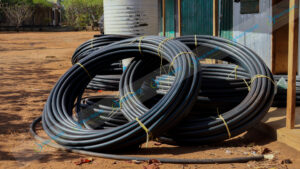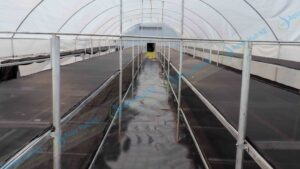Ready to use Coco peat is an extract of coconut husks which provides a better planting environment than ordinary soil. It has multipurpose uses in a variety of garden and backyard farming as well as greenhouse and in-house cultivation.
It is popular for growing in houseplants such as potted flowers and plants.
The nutrient and chemical free nature of coco peat makes it an environmentally friendly growing medium to use.
Coco peat can be used on its own or mixed with soil to boost the water retention and viability of soil.
Why is it Better than soil?
Coco peat mass particles are loose or less compact compared to soil particles. This makes drainage and wetting much faster and more efficient for water to reach plant roots.
Moreover, the rate of germination and root growth on coco peat is much faster than in soil.
The aeration in coco peat is excellent, for easier germination, oxygen reaches the soil and will be available for seed germination.
How to Make Coco Peat Ready to Use
- Coco peat is made from coconut husks, you just collect them, crush them into fine powder.
- Mix the coconut dust with water and soak them for about 10 minutes.
- Wash the coco peat to remove dirt, salt, and other impurities.
- Drain the water to get rid of dissolved salts and water.
- Spread the wet coco peat in a mat and dry in the sun.
- The dry extract contains pure coco peat free from salts and impurities, once it dries you can weigh and pack them. Coco peat can be packed in blocks of portable weights, they are mostly packed in 1 kg and 5 kg blocks.
- Packaging in blocks enhances efficiency to transport to various destinations without damaging them, spilling, or moistening them before use.
How to use Coco Peat Blocks
Once you purchase a coco peat block, you need to know how to apply it for growing your crops. The block normally weighs up to 5kg and can fill 10 seedling trays when properly expanded with water. A block can expand up to 3 times the original mass of its compact block.
To expand it, just slice the coco peat open and pour it in a bucket of water. The ratio of coco peat to water should be 1:3, that is, 1 kg of coco peat requires 3l of water.
Allow it to absorb water.
Pour the excess water out and place the moist coco peat in trays. Ensure it fills all the cells of the seedling trays.
You can proceed to plant seeds on the tray.
How Sustainable is Coco Peat (Ready to Use)
Coco Peat is a product of renewable coconut plants. This means that it cannot get exhausted and will still be available for use in hydroponic farming in future. You can also recycle coco peat since it does not decompose faster or loses its water retention ability.
The future of hydroponic farming is luminous, and the hope of a better and food secure future is nearing.
What is the alternative to Coco Peat?
Coco Coir is an alternative hydroponic medium to coco peat. It can work well as a potting mix or used alone to grow seedlings or as well mixed with soil to improve moisture retention.
Difference Between Coco Peat and Coco Coir
The properties of coco coir are like those of coco peat apart from its light and coarse structure. Furthermore, coco coir is slightly acidic than coco peat and may not be good for all crops.
Coco Peat Lowers Disease and weed growth
The neutral PH of coco peat prevents growth of weeds and spread of fungal diseases to your crops. In fact, bacteria availability is low thus you may need to add nitrogen and calcium rich fertilizers. You can add DAP fertilizers in small quantities to ensure no risk of leaching.
Which Irrigation System for Coco Peat?
Irrigation of plants grown using coco peat requires a smart method to avoid carrying the growth medium away. Drip irrigation is better because it avails water in small droplets of less force unlike other methods. In fact, potted plants are ideal to use drip methods to prevent water logging and nutrient loss.
Benefits
- Water retention and holding capacity is high due to its loose particles.
- Sustainable and eco-friendly growing medium
- High cation exchange capacity. Ions are easily exchanged in coco peat since ions can move freely in between the coco peat particles.
- Improves air circulation in the soil for easier and faster growth of roots and germinating seeds.
- Coco peat is organic and can work under various levels of acid or basic conditions.
- You can use them for hydroponics for at least 5 years.
- Coco peat easily absorbs nutrients soluble in water.
Uses of Coco Peat
- Coco peat is used for Hydroponic farming. You can use it to grow seedlings, seeds, and fruits.
- Potted mixture for potted plants and flowers.
- Greenhouse flower cultivation.
- Seedling and tree nurseries growing.
- Water absorbers in doors, mats, and pavements.
- Propagation in seedling trays.
Price of Coco Peat in Kenya
The cost of Coco Peat is KES 750 per 5 kg block.
Coco Peat Supplier in Kenya
Aqua Hub Kenya is a popular coco peat seller in Kenya, with best ready to use coco peat. The prices are affordable for available block sizes.
Call 0790719020
Frequently Asked Questions
- What is the Cost of Coco Peat?
750 per block - Where is coco peat sold?
Aqua Hub Kenya - What is the weight of a block?
5 kg - Is it possible to use coco peat in an open garden?
Yes, you can mix it with soil. - What ratio is it recommended mixing coco peat with soil?
You can mix coco peat with soil or compost manure on a ratio of 1:1. - Is it possible to apply coco peat directly?
You can use ready coco peat for hydroponic and potted plant growing. - Is Coco peat rich in nutrients?
Yes, coco peat has some traces of nitrogen and phosphorous and high levels of organic matter. - Can you add fertilizer to Coco peat?
It is recommended to add calcium ammonium nitrates to boost calcium and nitrogen levels. - Can you use Coco Peat in Planting Bags?
Absolutely, just like pots it can hold coco peat well to enhance seedling propagation.





